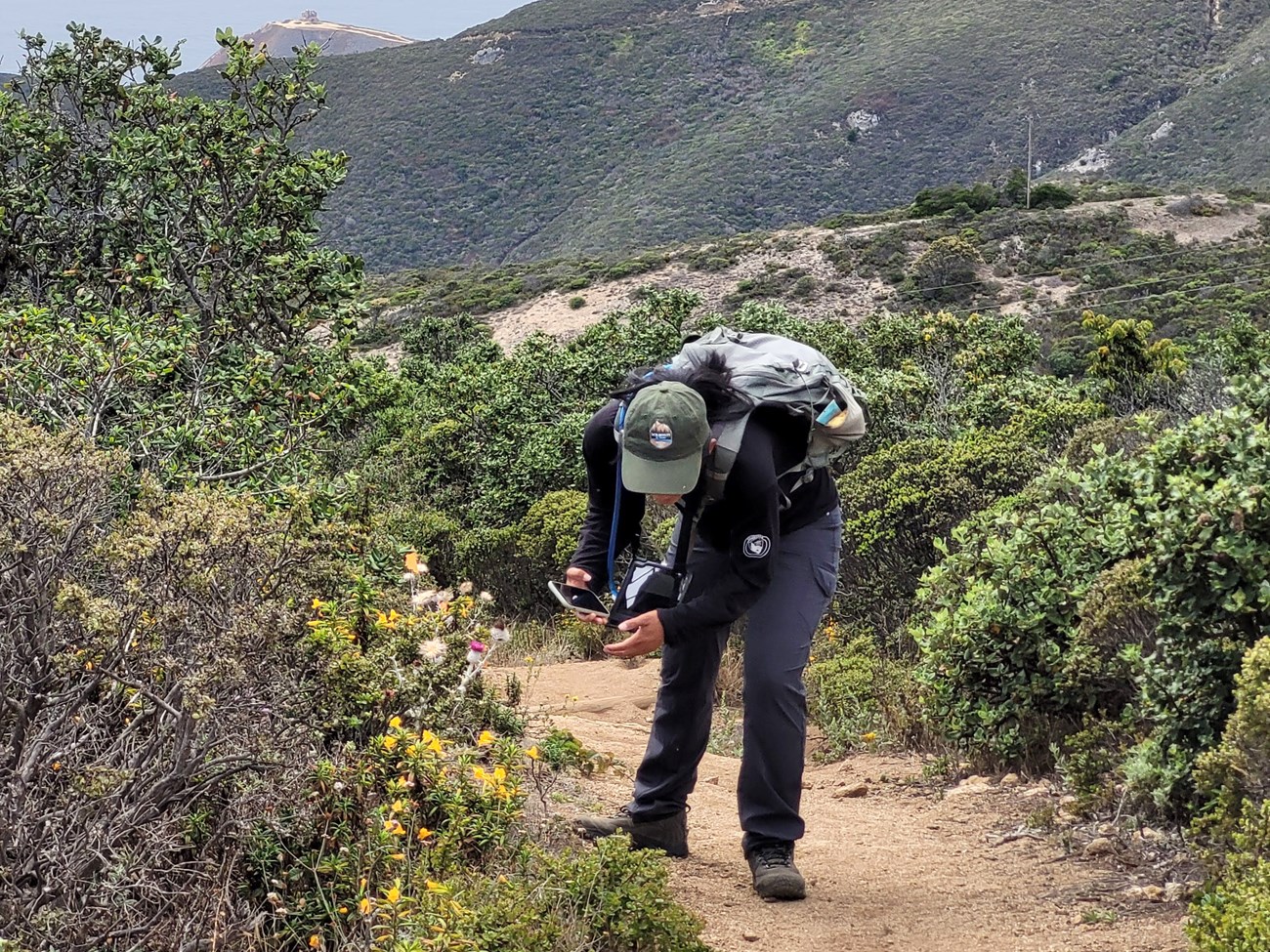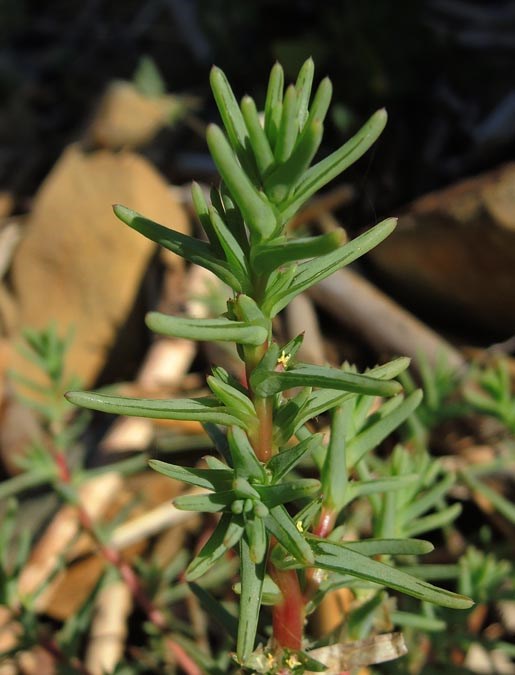Last updated: August 25, 2022
Article
Botany News – July 2022
Issue compiled by Plant Community Monitoring Intern Alexandria Knoell, San Francisco Bay Area Network Botany Program

NPS / Katherine Stratton
Fun Field Finds
Between ISED’s trail cruising and PCM’s off-trail plot-finding, the botany team stumbles across a great deal of miscellaneous items, from bovine bones to rubber ducks. Indeed, while the team was scouring a trailside for out-of-place plants this month, it was an out-of-place rubber duck that was spotted with its tail sticking out of the sorrel. As cute as a rubber duck may be, it is just as much a nuisance to the surrounding environment as the invasive plants that the ISED team works to document. Human-made litter is an unfortunate side effect of the heavy foot traffic that comes with popular trails and it's important to remember to carry out what you carry in!
Seeking Volunteers
In addition to keeping your trail excursions litter-free, you can make a positive impact on your favorite local park unit by joining the ISED team out in the field. The team is seeking volunteers for year-round invasive species surveys. Field days involve up to five miles of walking on easy to moderate trails, oftentime less. At least a general knowledge of invasive species of the Bay Area is preferred, and data collection training will be provided. Contact program botanist Lisa Schomaker at Lisa_Schomaker@nps.gov if you are interested!
July Botany Surveys
ISED
Rancho Corral de Tierra and the Presidio of San Francisco, Golden Gate National Recreation Area
As well as tackling the usual steep trails and switchbacks in Rancho this month, the ISED team began monitoring in the Presidio, so far covering most of Crissy Field and Fort Mason. The Presidio has turned out to be quite dense with invasive plants such as Rubus armeniacus and Hedera helix. Notably, the team detected new single occurrences of Limonium ramosissimum (Algerian sea lavender) and Salsola soda (opposite leaf Russian thistle) near Crissy Field.

NPS / Katherine Stratton
John Muir National Historic Site
The ISED team recently conducted a baseline survey at Mt. Wanda along with Tori Seher and the John Muir Natural Resources team. A noteworthy detection in this region was Centaurea solstitialis (yellow starthistle), which was found in high abundance throughout the site of the baseline survey. Interestingly, Tori informed us that this highly invasive species was not present in the area in the 2021 growing season. Tori suspects that these new, dense patches of C. solstisialis may be in part due to the extreme rainfall events that occurred in October and November of 2021.
This is not the first time C. solstitialis has received a spotlight in an ISED newsletter. In July 2018, small, isolated patches were spotted and treated in the Marin Headlands as well as Point Reyes National Seashore. Despite the relatively few sightings of C. solstitialis during the 2018 monitoring season, we predicted a coast-ward expansion of its range and abundance in the face of climate change over the next 30 years.
PCM
While last month's sites were characterized by bushwhacking through the dense shrubs of coastal scrub, freshwater marsh sites pose a whole new array of fun twists and turns, including chest high sedges hiding our transect markers and close-up cattle encounters.

NPS / Katherine Stratton
Perhaps the most notable quirk of freshwater wetland monitoring is the presence of cows. The evidence of cattle and other large ungulate visitation takes the form of flattened vegetation, deeply cut trails, and plenty of grazed plants (hungry grazers seem to particularly enjoy chomping on the inflorescence of Juncus phaeocephalus [brownhead rush]). Occasionally while monitoring, the botany team is even paid a visit by a small herd of cows, who curiously tread down to what is to them a glorious spread of snacks and are seemingly just as surprised as we are that there should be another presence there.

NPS / Alee Knoell
And of course, the much coveted Toxicodendron diversilobum (poison oak) remains a key player in site navigation. It is so coveted, in fact, that we dedicated a species spotlight to it, included in this issue.
Noteworthy Early Detections

Luigi Rignanese / CalPhotos / CC BY-NC 3.0
Yellow starthistle
(Centaurea solstitialis)
This month’s star invasive is the yellow star thistle, Centaurea solstitialis. Yellow star thistle is a lookalike and close relative to last month’s feature, tocalote. Just like tocalote, Centaurea solstitialis has ball-like flowers with fluffy yellow tops, branching stems, and narrow, erect leaves. While the two may seem identical at first glance, closer observation reveals a few key differences: yellow star thistle has larger, longer spines on its inflorescence than tocalote and lacks the purple phyllaries visible on tocalote buds. Tocalote also tends to have more densely clustered flowerheads that bloom earlier than yellow star thistle. This season the ISED crew observed tocalote flowering in April and May, but have only begun to see Yellow starthistle in bloom throughout June and July.
Both species are toxic to horses and other grazing animals, due to the presence of the compound repin. Over time, continued ingestion of repin leads to symptoms resembling Parkinson’s disease and eventual starvation due to lip and tongue paralysis.
Four years ago, we highlighted yellow starthistle in the July issue of what was then Early Detection News. At that time only four instances of yellow starthistle had been observed at John Muir NHS. To date in 2022, the ISED crew has observed 10 new occurrences of the persevering weed within the site, bringing the total of occurrences at John Muir to 20.
Resources:
CA invasive plant council management guide
Double Feature: Salt Marsh Madness

NPS / Katherine Stratton
Algerian sea lavender
(Limonium ramosissimum)
Limonium ramosissimum thrives near the water in coastal salt marshes, coastal scrubs, and riparian scrubs. In fact, it is one of the few invasive species that can grow in salt marshes. While there are small populations of Limonium ramosissimum surrounding the San Francisco Bay, so far this season only one occurrence has been documented in Crissy Field.
Native to the European Mediterranean, Limonium ramosissimum was brought over as an ornamental plant. Eventually, as the story goes for many introduced plants, it escaped captivity and began to spread around the introduced region. Limonium ramosissimum has small, dense basal leaves with multiple stems growing from each individual plant. These stems grow erect and may branch off on the upper stem toward the flower head. Limonium ramosissimum blooms from June to August with clusters of small white to purple terminal flowers. Thousands of seeds are dropped per plant, where they float on the changing tides and are viable for weeks after dispersal. The abundance of seeds dropped and their means of spreading poses a challenge to keeping track of populations if not managed in time.
Don’t confuse this invasive sea lavender with its native relative, Limonium californicum (California sea lavender)! L. californicum has much larger leaves and overall stature, but is found in the same habitat in the Bay Area.
Resources:

Jorg and Mimi Fleige / CalPhotos / CC BY-NC 3.0
Oppositeleaf Russian thistle
(Salsola Soda)
Salsola soda is a small, fleshy, and hairless shrub that can be found in salt marshes, mudflats, and in the upper portion of intertidal zones. Their leaves are opposite near the base of the plant and become alternate toward the top. Wide at the base, the leaves narrow to a rounded end giving it a spiky or thistly look from afar. Salsola blooms from July to October, and is then adorned with round, fleshy flowers that grow at the base of the leaf.
Another common name for Salsola soda is agretti, which may sound familiar to any avid pasta fans out there. Native to the European Mediterranean, Salsola is often used in pastas (i.e. agretti pasta). This makes it a very popular vegetable, though harmful to the wetlands here in the Bay Area. While germination success is low, once it succeeds, Salsola grows rapidly. Like Limonium, their seeds can float in water as well as germinate in areas with almost no soil. The Bay Area has many trails along the water’s edge, where bikes and shoes can also catch seeds and lead to the spread of existing populations.
Resources:
California Invasive Plant Council
Native Species Spotlight

NPS / Katherine Stratton
Poison oak
(Toxicodendron diversilobum)
You may remember from last month's edition that poison oak was highlighted as a vilified obstacle for the PCM team. While it does remain perhaps the greatest hazard to us as we navigate through various sites, we retain a certain reverence for it as a plant with incredible ecological benefits.
This underappreciated plant is an ecological powerhouse, providing forage and habitat for native wildlife. Every part of the plant contributes to its ecological value. The flowers support pollinators, and the persistent berries provide a year-round food source for birds and other animals. Browsing mammals and insects feed on the leaves without consequence, which boast a high density of nutritional content. Its roots provide an underground structure in which small mammals can burrow while its leaves provide material for bird nests, and the plant as a whole serves as a refuge in which many creatures may take shelter from predators.
Poison oak supports ecosystem resilience by outcompeting and thereby limiting the spread of some invasive species. It is a hardy plant that can quickly resprout after fire to occupy disturbed landscapes. In some areas, it is even cultivated in nurseries and used in landscape restoration! It is the most widespread shrub in California, occupying a wide variety of habitat types west of the Sierra Nevada and Mojave Desert (USFS).
Despite its ecological charms, let’s suppress the urge to give poison oak a hug and take a moment to ensure that we can quickly sight ID this plant and avoid touching it altogether. The various environmental conditions and seasonal changes in the many different habitat types in which it grows, combined with an individual plant’s physiological responses to these conditions (phenotypic plasticity), leads to great diversity in its growth forms and color, as indicated by the species name [Toxicodendron] diversilobum. Catch it blooming from March to June!
Resources:
Morro Bay National Estuary Program
ISED Survey Results
This month's ISED records may be viewed in an interactive map at the Calflora Observation Search website. Navigate to the Help Site for assistance using the Observation Search page.
